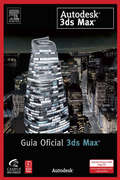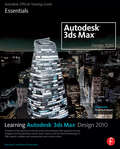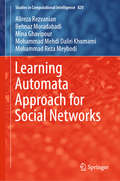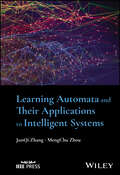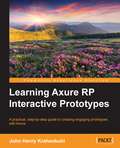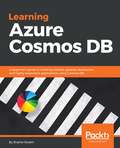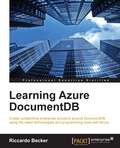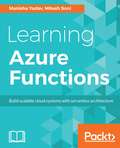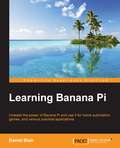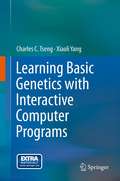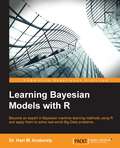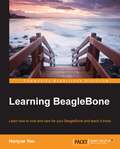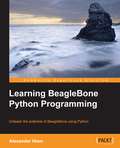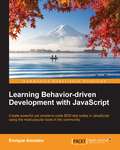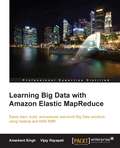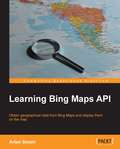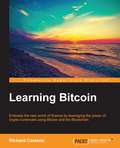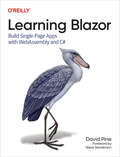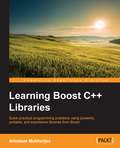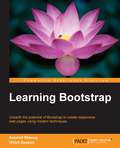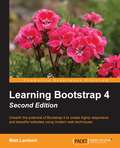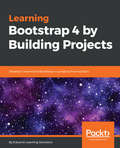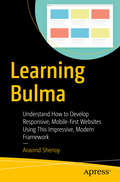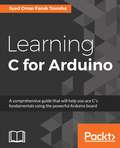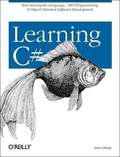- Table View
- List View
Learning Autodesk 3ds Max 2010 Foundation for Games
by Autodesk3ds Max XXXX: presently under NDA. Learning 3ds Max XXXX Foundation is the key to unlocking the power of Autodesk 3ds Max, directly from the creators of one of the world's most powerful 3D animation and effects software products. Get hands on experience with the innovative tools and powerful techniques available in the new version of 3ds Max, through all new project-based lessons. Projects will include valuable game assets and examples. Topics will include modeling, animation, materials & mapping, rendering. Autodesk will be contributing assets (models and images) from high-profile studios. The DVD will include: 30-day trial of Max XXXX, bonus short films, demos, hotkey reference, free models from turbosquid.
Learning Autodesk 3ds Max Design 2010 Essentials: The Official Autodesk 3ds Max Reference
by AutodeskLearning Autodesk 3ds Max XXXX Essentials is a superb end-to-end reference that provides users with complete info on all of the features and options available in the latest version of 3ds Max, so that users can learn how to use 3ds Max confidently in a production environment. Each chapter offers a series of lessons - which introduce the functional areas of Max and go over all associated features (with examples), and then a lab (which demonstrates a practical application of the lesson). Together, all of the lessons deliver and sound and complete approach to revealing the functions, features, and principles of 3ds Max XXXX. New Bonus section on MaxScript covering techniques for automating repetitive tasks and customizing 3ds Max to make you more productive.The DVD includes: Project Scene & support files, Free models & texture maps from Turbo Squid, NEW!! HIGH VALUE: Autodesk product Sketchbook Pro (for character development) valued at $199.99 US.
Learning Automata Approach for Social Networks (Studies in Computational Intelligence #820)
by Alireza Rezvanian Mohammad Reza Meybodi Behnaz Moradabadi Mina Ghavipour Mohammad Mehdi Daliri KhomamiThis book begins by briefly explaining learning automata (LA) models and a recently developed cellular learning automaton (CLA) named wavefront CLA. Analyzing social networks is increasingly important, so as to identify behavioral patterns in interactions among individuals and in the networks’ evolution, and to develop the algorithms required for meaningful analysis. As an emerging artificial intelligence research area, learning automata (LA) has already had a significant impact in many areas of social networks. Here, the research areas related to learning and social networks are addressed from bibliometric and network analysis perspectives. In turn, the second part of the book highlights a range of LA-based applications addressing social network problems, from network sampling, community detection, link prediction, and trust management, to recommender systems and finally influence maximization. Given its scope, the book offers a valuable guide for all researchers whose work involves reinforcement learning, social networks and/or artificial intelligence.
Learning Automata and Their Applications to Intelligent Systems
by MengChu Zhou JunQi ZhangComprehensive guide on learning automata, introducing two variants to accelerate convergence and computational update speed Learning Automata and Their Applications to Intelligent Systems provides a comprehensive guide on learning automata from the perspective of principles, algorithms, improvement directions, and applications. The text introduces two variants to accelerate the convergence speed and computational update speed, respectively; these two examples demonstrate how to design new learning automata for a specific field from the aspect of algorithm design to give full play to the advantage of learning automata. As noisy optimization problems exist widely in various intelligent systems, this book elaborates on how to employ learning automata to solve noisy optimization problems from the perspective of algorithm design and application. The existing and most representative applications of learning automata include classification, clustering, game, knapsack, network, optimization, ranking, and scheduling. They are well-discussed. Future research directions to promote an intelligent system are suggested. Written by two highly qualified academics with significant experience in the field, Learning Automata and Their Applications to Intelligent Systems covers such topics as: Mathematical analysis of the behavior of learning automata, along with suitable learning algorithms Two application-oriented learning automata: one to discover and track spatiotemporal event patterns, and the other to solve stochastic searching on a line Demonstrations of two pioneering variants of Optimal Computing Budge Allocation (OCBA) methods and how to combine learning automata with ordinal optimization How to achieve significantly faster convergence and higher accuracy than classical pursuit schemes via lower computational complexity of updating the state probabilityA timely text in a rapidly developing field, Learning Automata and Their Applications to Intelligent Systems is an essential resource for researchers in machine learning, engineering, operation, and management. The book is also highly suitable for graduate level courses on machine learning, soft computing, reinforcement learning and stochastic optimization.
Learning Axure RP Interactive Prototypes
by John Henry KrahenbuhlIf you are a user experience professional, designer, information architect, or business analyst who wants to gain interactive prototyping skills with Axure, then this book is ideal for you. Some familiarity with Axure is preferred but not essential.
Learning Azure Cosmos DB: A beginner's guide to creating scalable, globally distributed, and highly responsive applications using Cosmos DB
by Shahid ShaikhGain an in-depth understanding of Azure Cosmos DB — a multi-model database from Microsoft Key FeaturesDevelop your skills to build and scale applications using the power of Azure CosmosDB.Learn how to store and access data with a variety of APIs including MongoDB, Gremlin, SQL, Azure Tables and much more.Fast paced guide to have a better understanding of the features with the practical approach mentioned.Book DescriptionMicrosoft has introduced a new globally distributed database, called Azure Cosmos DB. It is a superset of Microsoft's existing NoSQL Document DB service. Azure Cosmos DB enables you to scale throughput and storage elastically and independently across any number of Azure's geographic regions.This book is a must-have for anyone who wants to get introduced to the world of Cosmos DB. This book will focus on building globally-distributed applications without the hassle of complex, multiple datacenter configurations. This book will shed light on how Cosmos DB offers multimodal NoSQL database capabilities in the cloud at a scale that is one product with different database engines, such as key-value, document, graph, and wide column store. We will cover detailed practical examples on how to create a CRUD application using Cosmos DB with a frontend framework of your choice. This book will empower developers to choose their favorite database engines to perform integration, along with other systems that utilize the most popular languages, such as Node.js. This book will take you through the tips and trick, of Cosmos DB deployment, management, and the security offered by Azure Cosmos DB in order to detect, prevent, and respond to database breaches.By the end of this book, you will not only be aware of the best capabilities of relational and non-relational databases, but you will also be able to build scalable, globally distributed,and highly responsive applications.What you will learnBuild highly responsive and mission-critical applicationsUnderstand how distributed databases are important for global scale and low latencyUnderstand how to write globally distributed applications the right wayImplement comprehensive SLAs for throughput, latency, consistency,and availabilityImplement multiple data models and popular APIs for accessing and querying dataImplement best practices covering data security in order to detect, prevent andrespond to database breachesWho this book is forThis book is intended to anyone who wants to get well versed with Microsoft's new NoSQL database called Azure Cosmos DB. Get the database into work with the practical examples mentioned.
Learning Azure DocumentDB
by Riccardo BeckerCreate outstanding enterprise solutions around DocumentDB using the latest technologies and programming tools with Azure About This Book * Get to know the concepts of DocumentDB and learn to work your way around it * Manipulate and query your documents using different modern technologies to access DocumentDB * Build a real-life scenario using Microsoft Visual Studio and C# with this handy and practical guide Who This Book Is For This book is for novice developers and database architects who need a thorough knowledge of the features of DocumentDB and developing applications with it. Basic knowledge of SQL would be helpful. What You Will Learn * Create, manage, and configure your DocumentDB environment * Execute SQL queries from simple to complex and nested ones against your database * Get to know about advanced DocumentDB techniques such as scopes, portioning, indexing, triggers, UDF's, and security * Fine-tune your DocumentDB database to optimize performance and costs * Interact with DocumentDB from different technologies and platforms * Build a real-life scenario using C# and put DocumentDB at the heart of Azure solutions * Understand how to migrate from your current datastore to DocumentDB In Detail Learning DocumentDB adopts a practical, step-by-step approach to help you learn the basics of DocumentDB and use your new-found abilities in real-life scenarios and enterprise solutions. We start with the absolute basics, such as setting up a DocumentDB environment, and guide you through managing your databases, and executing simple and complex queries. Next, we explain how to work with DocumentDB using the open REST protocol, and demonstrate how JavaScript works with DocumentDB. We'll also show you how to authenticate and execute queries. Moving on, you'll find out how to use DocumentDB from within Node.js to kick-start your Node.js projects. Next, you'll discover how to increase the performance of your DocumentDB database and fine-tune it. Finally, you'll get to grips with using DocumentDB in conjunction with other services offered from the Microsoft Azure platform. Style and approach This book can be used as a tutorial where you learn step by step, but also as a knowledge base to quickly look up recipes you can instantly utilize. Starting with the basics and moving on to advanced topics, every concept is explained in theory and demonstrated through easy-to-understand examples.
Learning Azure Functions
by Mitesh Soni Manisha YadavThis book will start with the basics of Azure Functions. You will learn the steps to set up the environment and the tools that we will be using in the further chapters. Once you have a better understanding of this, we will be creating our first hello world function app. Later you will be introduced to triggers, how they are used to activate a function, and how binding can be used to output results of a function.You will also explore the steps to create an assembly with complex functionality that can be used by functions. Next, this book will teach you to scale your functions and use them to process data, integrate systems, and build simple APIs and microservices. Finally, this book will cover some diagnostic techniques with Azure App services and best practices of working with Azure Functions. By the end of this book, you will be well-versed with the techniques of scaling your Azure functions and making the most of serverless architecture.
Learning Banana Pi
by Daniel BlairThis book is for anyone who wants to explore Banana Pi and get started building projects on their own using it. No prior experience of working with single board computers is required.
Learning Basic Genetics with Interactive Computer Programs
by Charles C. Tseng Xiaoli YangTraditionally, genetics laboratory exercises at the university level focus on mono- and dihybrid crosses and phenotypic analysis--exercises under traditional time, materials, and process constraints. Lately, molecular techniques such as gene cloning, polymerase chain reactions (PCR), and bioinformatics are being included in many teaching laboratories--where affordable. Human chromosome analysis, when present at all, has often been restricted to simple identification of chromosomes by number, through the usual "cut-and-paste" method. Although several online karyotyping (chromosome identification) programs have become available, they are not meaningful for studying the dynamics of the chromosome system, nor do they help students understand genetics as a discipline. The software that accompanies this book has been shown to be an ideal tool for learning about genetics, which requires a combination of understanding, conceptualization, and practical experience.
Learning Bayesian Models with R
by Dr Hari M. KoduvelyThis book is for statisticians, analysts, and data scientists who want to build a Bayes-based system with R and implement it in their day-to-day models and projects. It is mainly intended for Data Scientists and Software Engineers who are involved in the development of Advanced Analytics applications. To understand this book, it would be useful if you have basic knowledge of probability theory and analytics and some familiarity with the programming language R.
Learning BeagleBone
by Hunyue YauThis book is for new BeagleBone owners who are looking to quickly get their microboard up and running. It would be helpful to have an understanding of embedded concepts or Linux but neither is essential.
Learning BeagleBone Python Programming
by Alexander HiamIf you have experience with the Python language and are interested in getting started with electronics, then BeagleBone Black is the perfect platform for you and this book will provide you with the information you need.
Learning Behavior-driven Development with JavaScript
by Enrique AmodeoThis book is ideal for any JavaScript developer who is interested in producing well-tested code. If you have no prior experience with testing, Node.js, or any other tool, do not worry, as they will be explained from scratch.
Learning Big Data with Amazon Elastic MapReduce
by Amarkant Singh Vijay RayapatiThis book is aimed at developers and system administrators who want to learn about Big Data analysis using Amazon Elastic MapReduce. Basic Java programming knowledge is required. You should be comfortable with using command-line tools. Prior knowledge of AWS, API, and CLI tools is not assumed. Also, no exposure to Hadoop and MapReduce is expected.
Learning Bing Maps API
by Artan SinaniThis is a practical, hands-on guide with illustrative examples, which will help you explore the vast universe of Bing maps.If you are a developer who wants to learn how to exploit the numerous features of Bing Maps then this book is ideal for you. It can also be useful for more experienced developers who wish to explore other areas of the APIs. It is assumed that you have some knowledge of JavaScript, HTML, and CSS. For some chapters a working knowledge of .Net and Visual Studio is also needed.
Learning Bitcoin
by Richard CaetanoEmbrace the new world of fiance by leveraging the power of crypto-currencies using Bitcoin and the BlockchainAbout This BookSet up your own wallet, buy and sell Bitcoin, and execute custom transactions on the BlockchainLeverage the power of Bitcoin to reduce transaction costs and eliminate fraudA practical step-by-step guide to break down the Bitcoin technology to ensure safe transactionsWho This Book Is ForIf you are familiar with online banking and want to expand your finances into a resilient and transparent currency, this book is ideal for you. A basic understanding of online wallets and financial systems will be highly beneficial to unravel the mysteries of Bitcoin.What You Will LearnSet up your wallet and buy a Bitcoin in a flash while understanding the basics of addresses and transactionsAcquire the knack of buying, selling, and trading Bitcoins with online marketplacesSecure and protect your Bitcoins from online theft using Brainwallets and cold storageUnderstand how Bitcoin's underlying technology, the Blockchain, works with simple illustrations and explanationsConfigure your own Bitcoin node and execute common operations on the networkDiscover various aspects of mining Bitcoin and how to set up your own mining rigDive deeper into Bitcoin and write scripts and multi-signature transactions on the networkExplore the various alt-coins and get to know how to compare them and their valueIn DetailThe financial crisis of 2008 raised attention to the need for transparency and accountability in the financial world. As banks and governments were scrambling to stay solvent while seeking a sustainable plan, a powerfully new and resilient technology emerged.Bitcoin, built on a fundamentally new technology called "The Blockchain," offered the promise of a new financial system where transactions are sent directly between two parties without the need for central control.Bitcoin exists as an open and transparent financial system without banks, governments, or corporate support. Simply put, Bitcoin is "programmable money" that has the potential to change the world on the same scale as the Internet itself.This book arms you with immense knowledge of Bitcoin and helps you implement the technology in your money matters, enabling secure transactions.We first walk through the fundamentals of Bitcoin, illustrate how the technology works, and exemplify how to interact with this powerful and new financial technology. You will learn how to set up your online Bitcoin wallet, indulge in buying and selling of bitcoins, and manage their storage. We then get to grips with the most powerful algorithm of all times: the Blockchain, and learn how crypto-currencies can reduce the risk of fraud for e-commerce merchants and consumers.With a solid base of Blockchain, you will write and execute your own custom transactions. Most importantly, you will be able to protect and secure your Bitcoin with the help of effective solutions provided in the book. Packed with plenty of screenshots, Learning Bitcoin is a simple and painless guide to working with Bitcoin.Style and approachThis is an easy-to-follow guide to working with Bitcoin and the Blockchain technology. This book is ideal for anyone who wants to learn the basics of Bitcoin and explore how to set up their own transactions.
Learning Blazor: Build Single-Page Apps with WebAssembly and C#
by David PineTake advantage of your C# skills to build UI components and client-side experiences with .NET. With this practical guide, you'll learn how to use Blazor WebAssembly to develop next-generation web experiences. Built on top of ASP.NET Core, Blazor represents the future of .NET single-page application investments. Author David Pine, who focuses on .NET and Azure content development at Microsoft, explains how WebAssembly enables many non-JavaScript-based programming languages to run on the client browser. In this book, you'll learn about real-time web functionality with ASP.NET Core SignalR and discover strategies for bidirectional JavaScript interop. David also covers component data binding, hierarchical event-driven communications, in-memory state management, and local storage. This book shows you how to: Create a beautiful, feature-rich Blazor appDevelop and localize an enterprise-scale app using GitHub Actions and Azure Cognitive Services TranslatorCreate advanced validation scenarios for input-based components with formsAutomatically deploy and host to Azure Static Web Apps, and rely on HTTP servicesUse a geolocation service and speech synthesis and recognition native to the browserAuthor a custom modal verification mechanism for validating a user
Learning Boost C++ Libraries
by Arindam MukherjeeIf you are a C++ programmer who has never used Boost libraries before, this book will get you up-to-speed with using them.<P><P> Whether you are developing new C++ software or maintaining existing code written using Boost libraries, this hands-on introduction will help you decide on the right library and techniques to solve your practical programming problems.
Learning Bootstrap
by Aravind Shenoy Ulrich SossouIf you want to learn to build enterprise-level websites efficiently with Bootstrap, this book is for you. You must have a basic and fundamental understanding of HTML, CSS, and JavaScript; however, there is no need to have prior Bootstrap experience.
Learning Bootstrap 4 - Second Edition
by Matt LambertUnearth the potential of Bootstrap 4 to create highly responsive and beautiful websites using modern web techniques About This Book * This book shows how to take advantage of the all new features introduced in Bootstrap * Learn responsive web design and discover how to build mobile-ready websites with ease * Find out how to extend the capabilities of Bootstrap with a huge range of tools and plugins, including jQuery, * Do more with JavaScript and learn how to create an enhanced user experience Who This Book Is For If you want to learn to build enterprise-level websites efficiently with Bootstrap, this book is for you. You must have a basic and fundamental understanding of HTML, CSS, and JavaScript; however, there is no need to have prior Bootstrap experience. What You Will Learn * Fire up Bootstrap and set up the required build tools to get started * See how and when to use Flexbox with the Bootstrap layouts * Find out how to make your websites responsive, keeping in mind Mobile First design * Work with content such as tables and figures * Play around with the huge variety of components that Bootstrap offers * Extend your build using plugins developed from JavaScript * Use Sass to customize your existing themes In Detail Bootstrap, the most popular front-end framework built to design elegant, powerful, and responsive interfaces for professional-level web pages has undergone a major overhaul. Bootstrap 4 introduces a wide range of new features that make front-end web design even simpler and exciting. In this gentle and comprehensive book, we'll teach you everything that you need to know to start building websites with Bootstrap 4 in a practical way. You'll learn about build tools such as Node, Grunt, and many others. You'll also discover the principles of mobile-first design in order to ensure your pages can fit any screen size and meet the responsive requirements. Learn to play with Bootstrap's grid system and base CSS to ensure your designs are robust and that your development process is speedy and efficient. Then, you'll find out how you can extend your current build with some cool JavaScript Plugins, and throw in some Sass to spice things up and customize your themes. This book will make sure you're geared up and ready to build amazingly beautiful and responsive websites in a jiffy. Style and approach With the help of several real-world examples and code, this book will teach you to build a full-featured responsive website in Bootstrap, which is mobile-ready.
Learning Bootstrap 4 by Building Projects: Develop 5 real-world Bootstrap 4.x projects from scratch
by Eduonix Learning SolutionsPractical guide to learning responsive web development with the powerful JavaScript Library, BootstrapKey FeaturesCreate 5 responsive web apps with Bootstrap 4Use elements and full Bootstrap toolkit to construct custom animations and templatesDesign, customize, and create existing UIs and media aggregator appsBook DescriptionBootstrap, the world’s most popular frontend framework, is an open source toolkit for building web applications with HTML, CSS, and JavaScript.Learning Bootstrap 4 by Building Projects covers the essentials of Bootstrap 4 along with best practices. The book begins by introducing you to the latest features of Bootstrap 4. You will learn different elements and components of Bootstrap, such as the strict grid system, Sass, which replaced Less, flexbox, Font Awesome, and cards. As you make your way through the chapters, you will use a template that will help you to build different kinds of real-world websites, such as a social media website, a company landing page, a media hosting website, and a profile page, with ease.By the end of this book, you will have built websites that are visually appealing, responsive, and robust.What you will learnGet familiar with the new features of Bootstrap 4Understand how the new grid system worksLearn to use the Sass tool in BootstrapAutomate your tasks using the task runner, GulpUse Lightbox to build a photo galleryMaster best practices for HTML, CSS, and JavaScriptWho this book is forLearning Bootstrap 4 by Building Projects is for web developers who want to build real-world responsive websites from scratch using Bootstrap 4. Basic knowledge of HTML and CSS is required.
Learning Bulma: Understand How to Develop Responsive, Mobile-first Websites Using This Impressive, Modern Framework
by Aravind ShenoyLearn to use Bulma in your HTML file by applying easy-to-understand practical examples to create responsive and mobile-first websites.Featuring a step-by-step approach, this book encourages you to modify its code examples and review the changes produced in the output, to thereby reveal the subtle nuances of this awesome utility. Bulma is an impressive, modern framework utility that allows the easy construction of web pages thanks to the highly flexible Flex-box grid styles and simple syntax. You'll see how to use Bulma’s intuitive CSS capabilities to create interactive websites that support responsive design by dynamically adjusting the layout resulting in an optimal viewing experience. You'll then delve into typical modifiers, columns, Flex-box grid styles, forms, elements, utilities, CSS components, and more. By the end of this book, you will be familiar with the inner workings of Bulma at an intermediate level and be equipped to aptly leverage Bulma’s utilities to streamline your web designing experience. What You'll LearnGet started quickly with Bulma Use the grid system, layout, content, and modifiersLeverage Bulma’s built-in CSS utilitiesStreamline the web design experience with Bulma’s flexible attributesEffectively take a mobile-first approachWho This Book Is ForBeginners who have a basic understanding of HTML, CSS and JavaScript.
Learning C for Arduino
by Syed Omar TowahaUltimate guide for programming Arduino with C About This Book • Get hands-on experience with the Ardruino board and learn to control it with your programming skills • Learn the essential concepts of C such as variables, data structures, functions, loops, and pointers • Work with electronic devices such as LEDs, switches, and motors and connect them to Arduino using C Who This Book Is For This book is for hobbyists who have no knowledge about programming and microcontrollers, but are keen to learn C programming using a very affordable hardware device. What You Will Learn • Play with mathematical operations using C • Use logical operations and loops to play with LEDs and the Arduino board • Create custom functions using C and connect an SD card to the Arduino • Use Object-oriented Programming to connect a GSM module to the Arduino board • Play with an LCD board and Servo using standard Arduino libraries • Build projects using Arduino such as a LED cube, a smart weather system, and home security • Identify and fix common errors on an Arduino board In Detail This book will start with the fundamentals of C programming and programming topics, such data types, functions, decision making, program loops, pointers, and structures, with the help of an Arduino board. Then you will get acquainted with Arduino interactions with sensors, LEDs, and autonomous systems and setting up the Arduino environment. Moving on you will also learn how to work on the digital and analog I/O, establish serial communications with autonomous systems, and integrate with electronic devices. By the end of the book, you will be able to make basic projects such as LED cube and smart weather system that leverages C. Style and approach This comprehensive step-by-step guide starts with the basic concepts of C for your Arduino board. It will teach you how to leverage C to explore the capabilities of Arduino.
Learning C#
by Jesse LibertyWith Learning C#, best-selling author Jesse Liberty will help you build a solid foundation in .NET and show how to apply your skills by using dozens of tested examples. You will learn how to develop various kinds of applications--including those that work with databases--and web services. Whether you have a little object-oriented programming experience or you are new to programming altogether, Learning C#will set you firmly on your way.
